Above right. Copy of original account. Cathedral Library-
(1687) The clock. January 31 received from Mr. Standish ye sum of Seven Pounds for repairing and turning ye Clock into a pendulum and to have 2 Pounds more if it be approved of by Mr. Patrick? and Mr.Turner ?
rec'd by me John Watts.
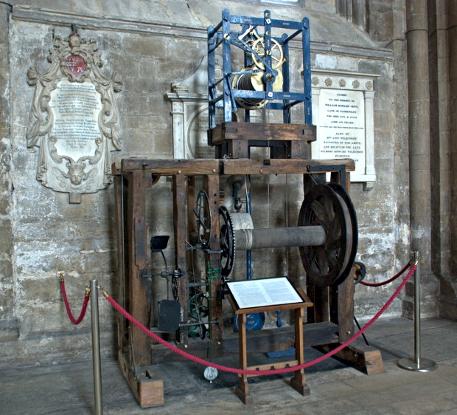
Peterborough Cathedral clock. The mechanism was built between oak posts inside a wooden frame. It is now stands unused on display in the north aisle. The parts date from the 1400s to 1830s. John Watts turned it into a pendulum by removing the foliot (an ancient type of regulator) shown below left. By the mid 1600s the pendulum had been developed and many movements were replaced or converted enabling accuracy to within a few seconds each day. The blue timekeeping movement standing on the top of the frame was made by John Wilson of Peterborough in 1836. It replaced the Watts movement and originally stood on the floor of the clock chamber but in this display it is in working order. Its long pendulum hangs at the rear and just clears the floor. The very early striking train (with the large wheels) sits directly under. This is also in working order. If you are interested ask one of the vergers to wind the clock.

The centre photograph shows the wrought iron escape wheel and anchor. The next photograph shows the complete movement less the pendulum which was missing. It hung between the prongs of the crutch (photograph right). The type of pendulum that was used is depicted on the right. Most clocks require a bell and it is likely that it was one of the largest of ten pre-reformation bells in the Cathedral at that time. In 1709 the bells were all recast by Henry Penn, a contemporary of John Watts. Restoration of the clock was by the writer in 1984.
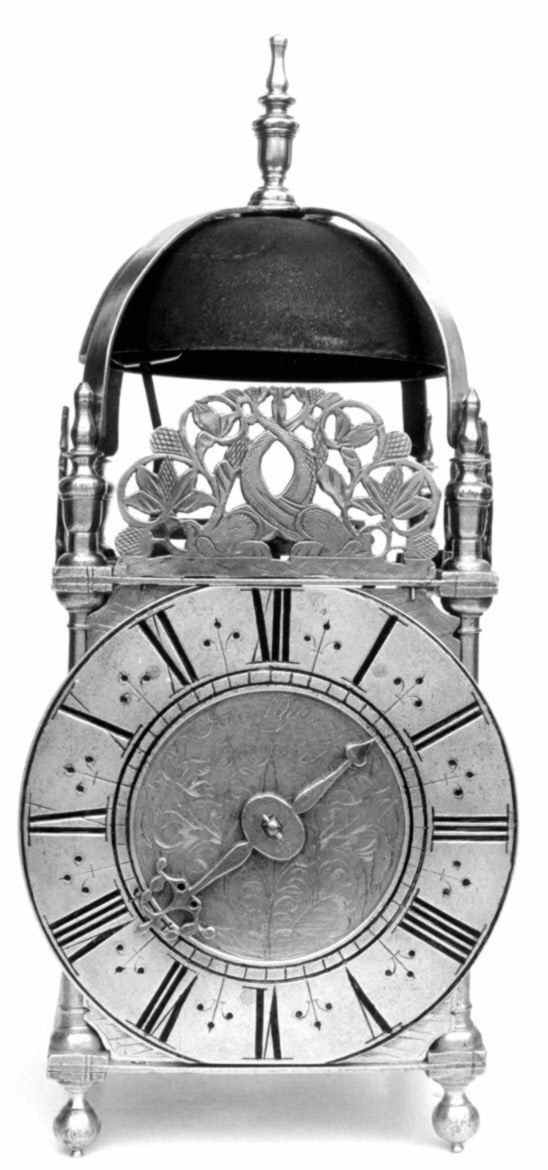
Lantern clock made by John Watts c1680. It was purchased from America, where it it is thought to have been taken by early settlers. When unpacked it was found to have been unused for some years as it was covered in verdigris. The new owner had it cleaned and restored to its original condition.
This small clock would stand on a wooden bracket with the driving weight hanging below.
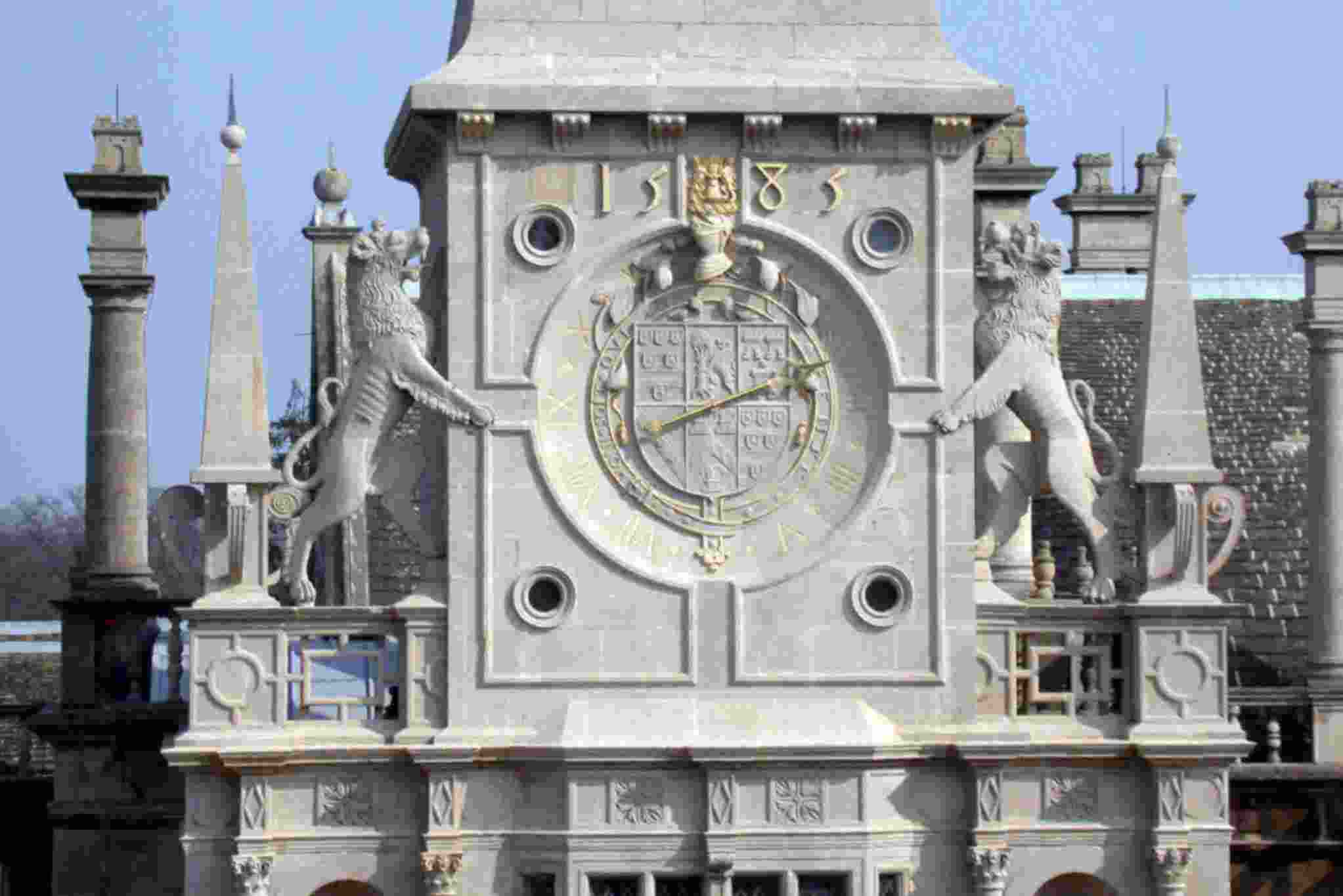
Burghley 4 o clock.mp3
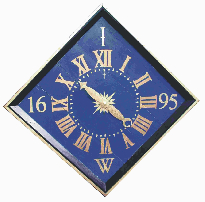
Wooden dial is made from four one foot wide oak planks joined together to make a four feet square dial, held together with a wooden frame. It was discarded from Ashwell church in Rutland. It is typical to the one on the drawing below on the side of William Brown's Hospital Stamford, a 15th century building
Turret clocks made by John Watts. Four have his signature IW. Other clocks in the area could be attributed to this maker.
* Existing movements.
William Browne’s Hospital, Stamford 1684
Empingham church clock IW1686*
Peterborough cathedral clock 1687*
Clipsham church clock IW 1688*
Milton Hall Peterborough 1691
Kings Cliffe church clock 1692
Nassington Church Clock IW1695*
Apethorpe Church Clock IW1704*
All Saints Stamford 1705*
Saint Michael Uffington, near Stamford 1707
Burghley House Stamford 1707
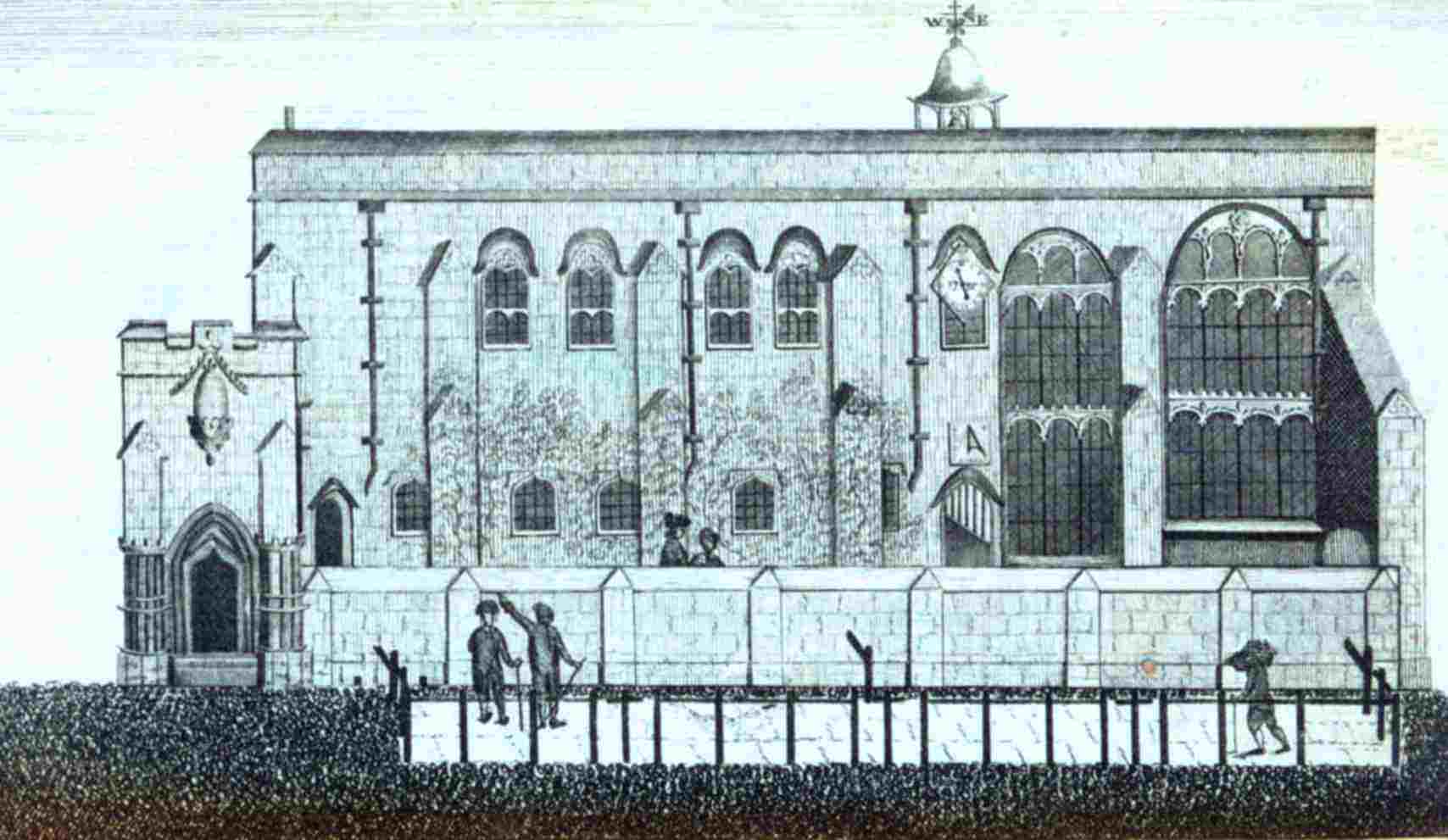
Brown's Hospital.
This wonderful building shown here stands in Broad Street Stamford.Up the ladder!.mp3
Listen to 'Up the ladder' sound recording above then read this conclusion.
It was some weeks later when a second formidable task took place. ‘The thing’ was lowered onto the church floor. ‘What are we going to do with this heap of rubbish’ was the general remark. At this early stage it was obvious that this so-called heap of rubbish had been the timekeeper for the village. Some cleaning revealed the extent of the clock movement and that some parts were missing. Cut into one of the upper horizontal wooden members were the letters and figures I. W. 1695. This was exciting. It was now well worth all the effort. The next task was to find who owned the initials and who had made this clock for the village some three hundred years ago. It was a case of who was I.W?
Watercolour right by Derek Abel. Shows the ladder leading up to the ancient clock at Nassington.
Below the adventurer, restorer, webpage maker and writer. Left the Nassington clock as found. Right the clock restored in Stamford Museum1982. It is signed on the top wooden rail IW 1695. Ioannes/John Watts 1695
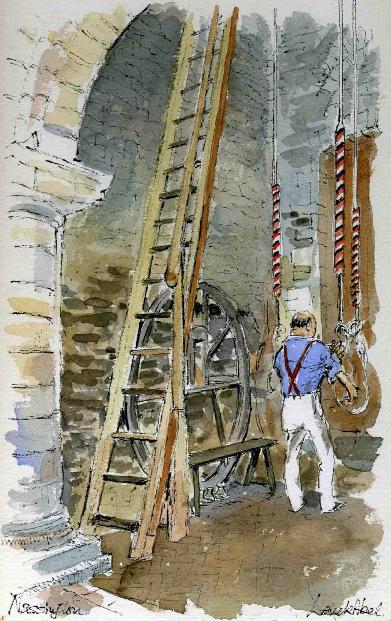
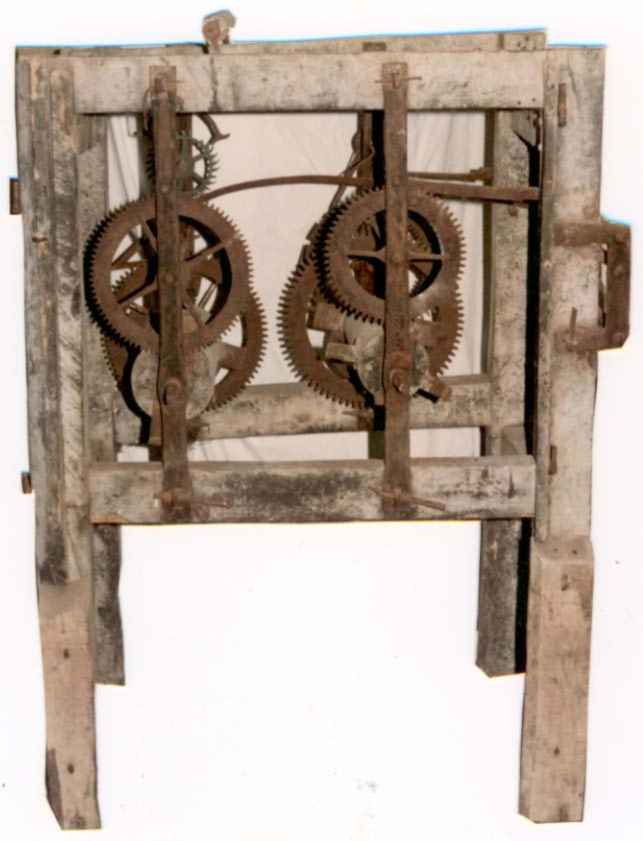
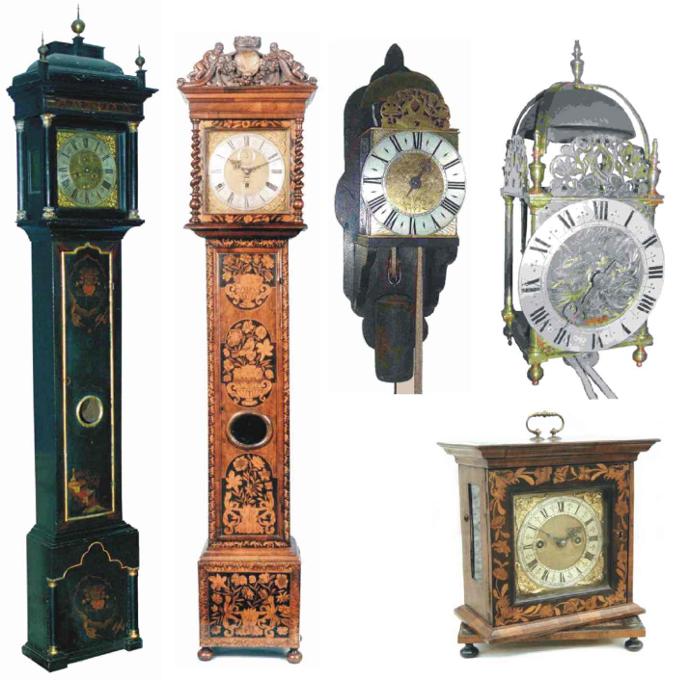
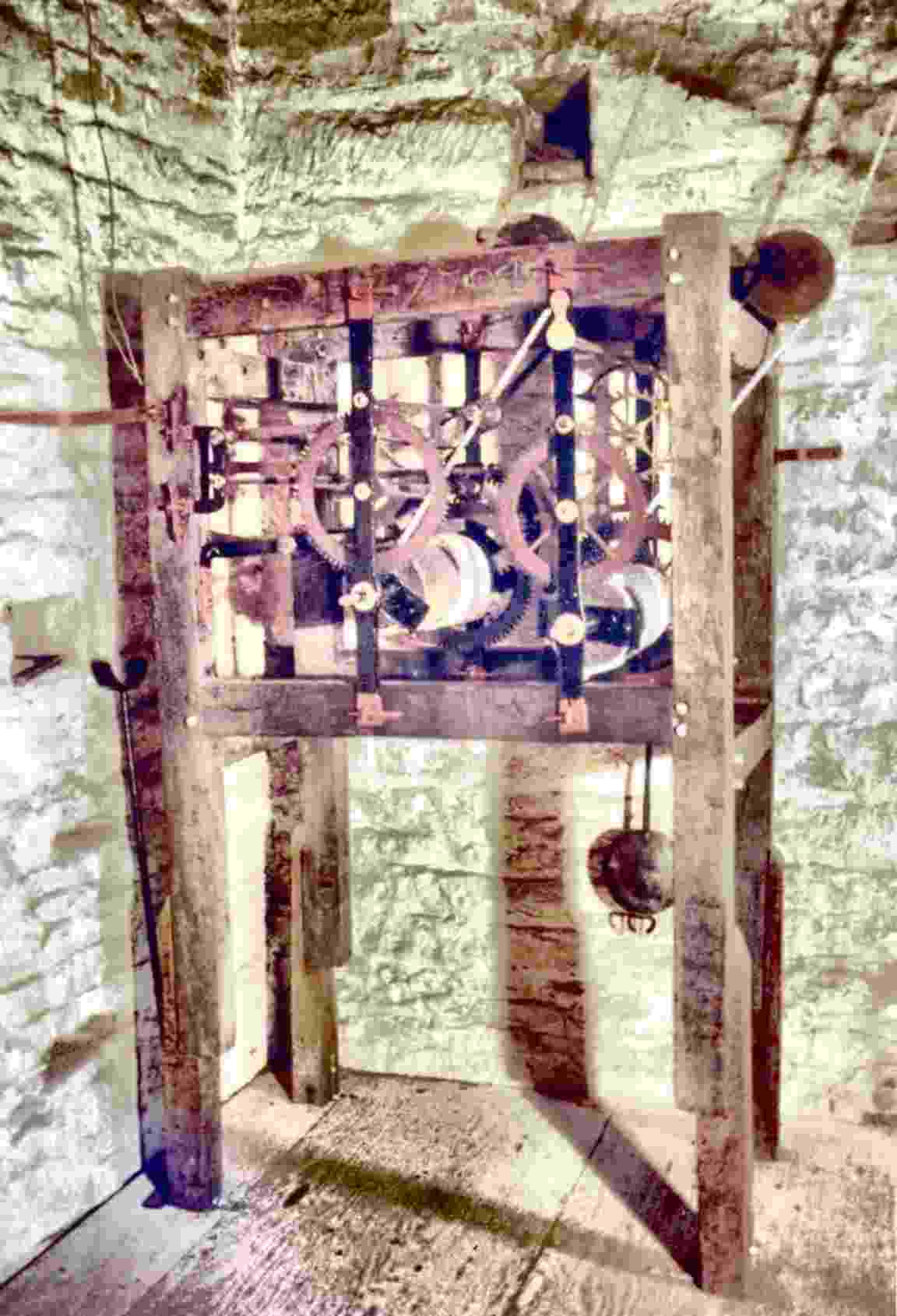
Above. Just a small selection of the clocks made by John Watts. From the left- longcase clock in black Japan, standing in the Mayor's Parlour at Stamford Town Hall.--Longcase musical clock in fine marquetry case. At one time it sold for £40.000.---Lantern bracket clock. ----Swivel mantle clock-----Top right early lantern clock signed 'John Watts Apethorpe fecit. It is possible that it was one of the first clocks made by him as it is the only clock known not to be made at Stamford. Northamptonshire Records Office have Apethorpe church records where we find the early Watts family in Apethorpe from 1684 who were mainly blacksmiths . Prior to this the records are unreadable. We met English Heritage at Apethorpe Hall to satisfy our curiosity. We found that the room above the main gate was called the clock chamber. To the side of this room spiral steps led upwards to a bell. 1629 Inventory (NRO W (A) box 6 parcel 5--In the clock chamber a bell and a rope). Other clocks are mentioned in the same inventory- 'Mr. Watts has looked after my two clocks'. Left. a photograph of the Apethorpe church clock restored by the writer in 1983. The dial was also restored to the original colour with gold leaf lettering. The diamond shaped wooden dial above was painted in the same style. This early turret clock signed IW 1704 is wound every day and keeps good time. In 2016 a lantern clock came up for sale by John Watts junior. He had become free to trade after being apprenticed to his father.
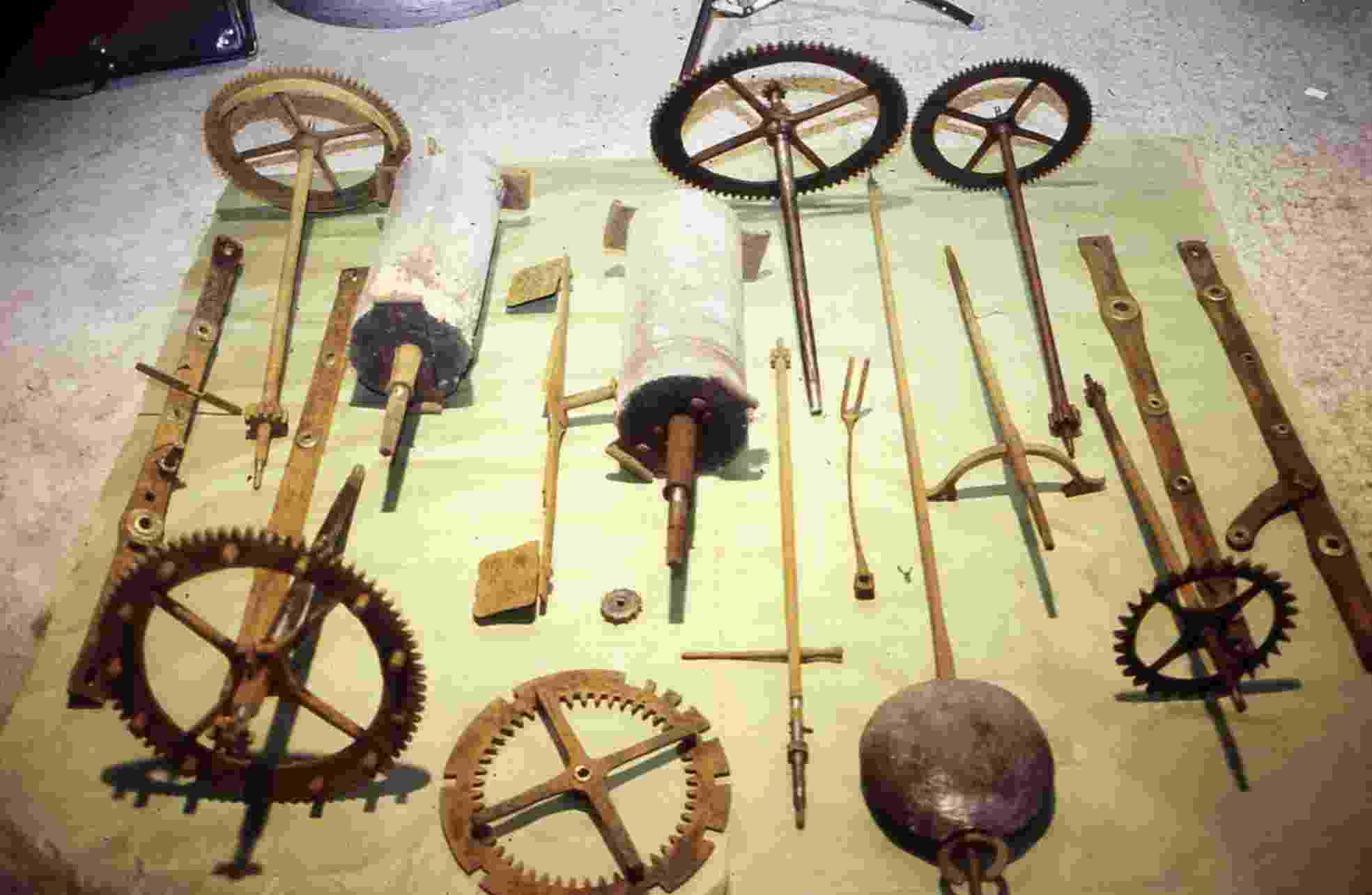
Watts must have served under a London, or equivalent, master and that he may have been sponsored by the Earl of Westmorland. His blacksmith relatives in Apethorpe made the wrought iron parts for his turret clocks under his design and he fitted these parts between the four wooden posts. The parts for most of the other clocks were made in Stamford. Thirty years of exciting research has proved that John Watts was the father of all Stamford clockmakers. The work may be copied by others but I hope they put my name to it. Left. All the parts of the Apethorpe clock, except ropes and weights. Photograph taken in 1983. On the left of the photo is the striking train pivot bars and wheels. Right. Pivot bars and going train. (Timekeeper). A early early map of Apethorpe shows the position of the Watts house near to what is known as the Willow Brook marked in red. The upper red dot shows the position of some land.
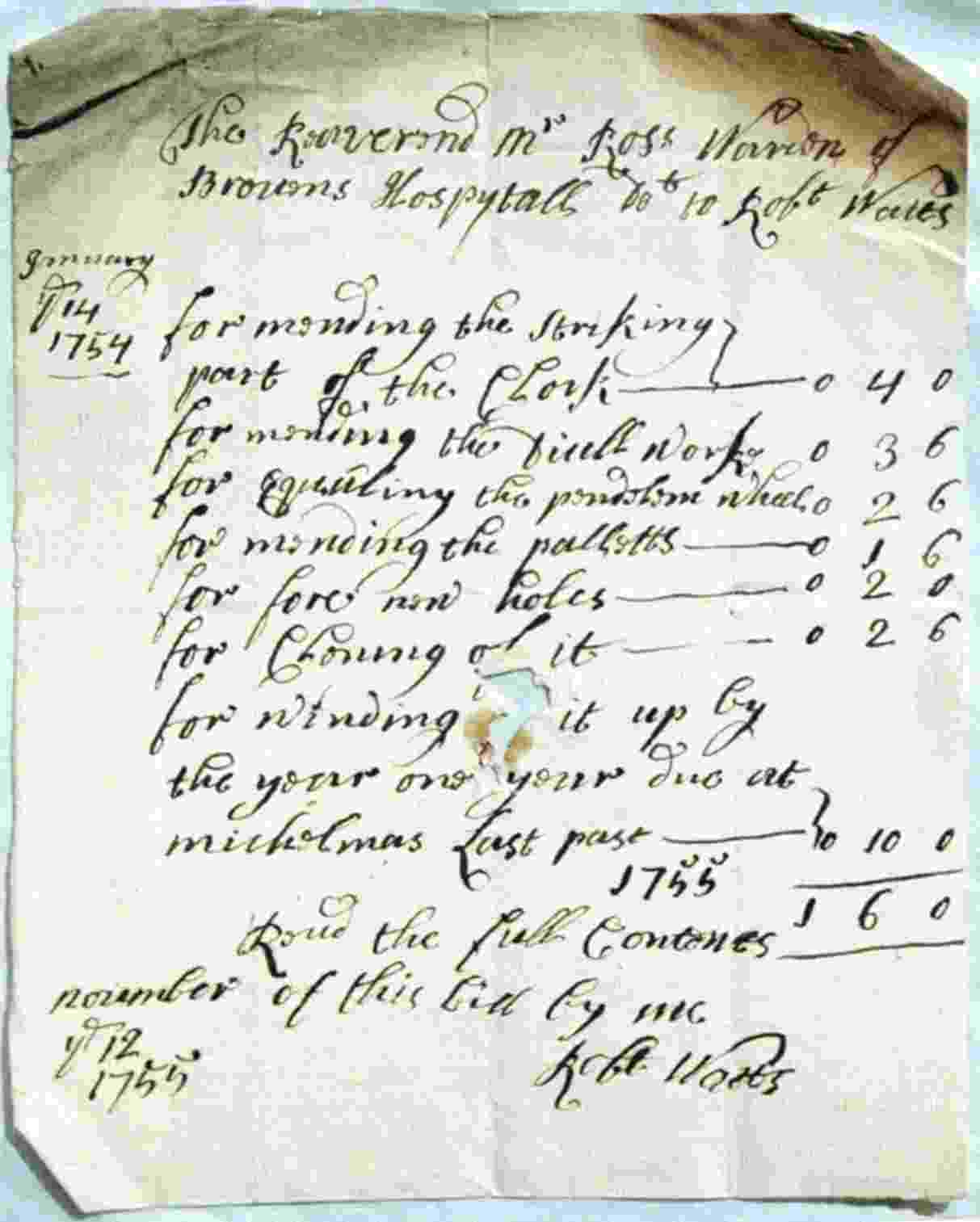
My special thanks to Philip Snowden, Roehampton, London. As without the help from this old Stamford boy, the writer would have given up.
This is only a part of the story. Robert Watts, son of John, carried on when his father died. He became a prolific clockmaker and with his wife Hannah kept his father's turret clocks in order. One in particular was at Browne's Hospital shown above which he maintained for 50 years. Our search in the Hospital papers was most successful. It cross sectioned all the previous work, and its provenance. A memorial to both Robert and Hannah was at one time on the wall of St John's Church Stamford.
Harrods History of Stamford.
One of fifty invoices found.
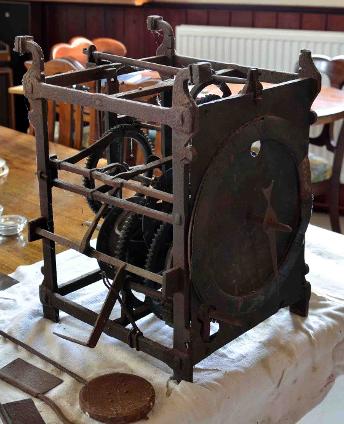
Cold Ashby St. Denis Church Clock.
A mysterious restoration.
After repairing Apethorpe church clock I was asked by the (clock keeper) would I accept a gift for payment? It was to be an ancient turret clock that belonged to the lady's late father. I had shown this clock years ago and at the time I was envious for possession. The owners father had been given the clock by the churchwardens of St. Denis Church Cold Ashby, Northamptonshire in 1943.
Left. As gifted-
A wrought iron frame 12 inches by 12 inches 17 inches high housing a going and striking train of gears. Sadly it was a missing finial, original pendulum and one weight. It and all its working parts were originally made on the blacksmiths forge.
A small movement did a mighty job. A clock collector friend has a number of lantern clocks in his collection and says that the Cold Ashby movement is very similar. Although Ashby (we will call it) is four times larger than a standard lantern clock it as all the attributes of one.
The larges the tenor is dated 1317 possibly the oldest bell in the country. This must have been the clock bell for the ancient and the modern clock. It is said that this early bell was given by the Abbot of Coventry.
Two bells were added in 1606 by Newcombe of Leicester.
A forth bell was added in 1883.
A new clock was purchased from Smith’s of Derby in 1914/17.
Ashby became unused and was known to be on the church floor in 1943.
About the same time Ashby was given to Mr. Lister by the churchwardens.
In 2017 Ashby came into the hands Michael Lee.
A letter dated 6th August 1943 in the possession of this writer confirms this gifting. The site owner tried but failed to contact the Churchwardens 2017.
The ring of four bells was augmented to six in 2002 when the tower was restored and the clock converted to electric wind.
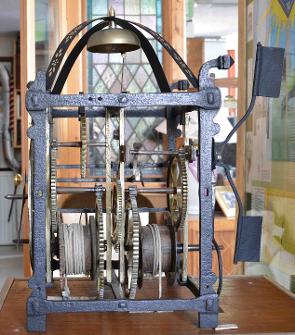
Three different periods of its life have been determined during cleaning.
First. When it was purchased c1606. All the parts were made of wrought iron by the blacksmith. It retains a number of these parts including the frame from which one finial is broken. The lifting levers, winding barrels, one with a wrought iron wheel used today for winding the going train. The original winding squares (on which the winding handle fits) are very worn.
The second period. The striking train was replaced with heavy brass square spoke wheels. The count wheel is unusual as it has Roman numerals on each time cam I to XII.
Third period. The going train (time keeper) was replaced with brass wheels and the foliot balance was removed and a pendulum and escape wheel took its place.
The evidence for this- A cock with a bearing for the pendulum to hang is fitted with two screws and a bearing housing has been braised in the centre of the front top horizontal bar. Between these bearings is the anchor and its related arbour.
Technical details.
Directly behind the dial is a thin brass twelve-hour wheel, which has 60 teeth and a drive spindle to the single hand. The section consists of four parts. An arbor onto which is mounted a wheel with twelve large spokes for triggering the hours on the striking train. This fits flat against the 60-tooth wheel. The four parts are held tight with a clutch arrangement for final adjustment.
The arbor projects four inches through the dial ending in a rounded point with a hole through for a cotter pin.
All the above is loose until the brass dial is fitted into two bottom lugs and held at the top with one pin. The 60-tooth wheel engages into a solid pinion with 10 teeth on the end of the winding barrel, which has, the only wrought iron wheel (now used for winding) and a conventional click connected to the winding squares. The great wheel on the barrel has 80 teeth. The next wheel has a pinion of 10 and an arbor to a wheel with 72 teeth. Next a pinion with 8 teeth and an arbor to the escape wheel which has 42 teeth, turning anticlockwise.